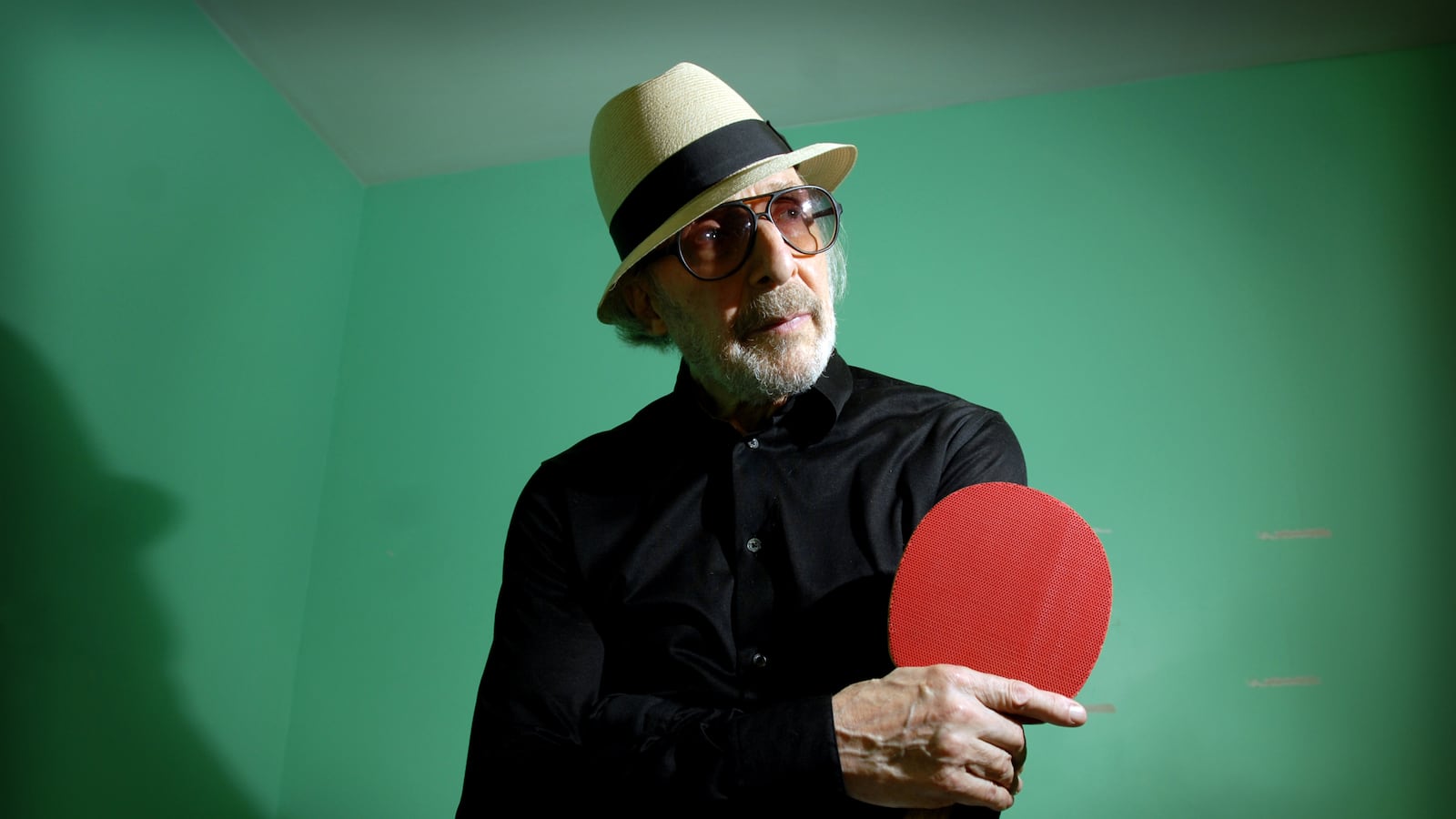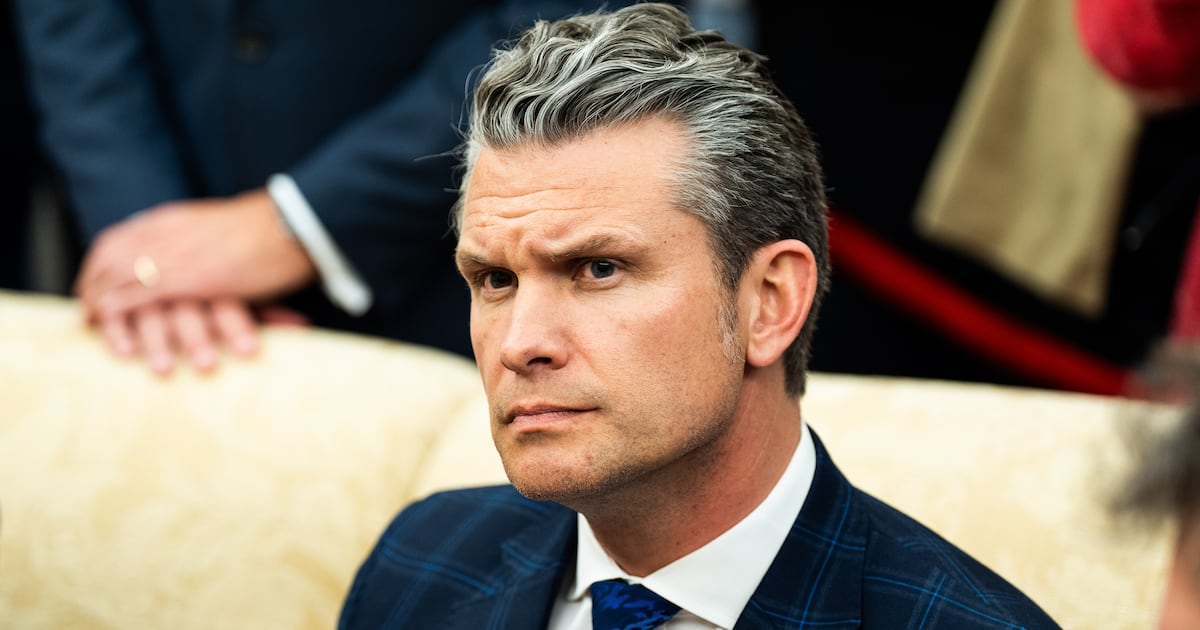Watch the newsreel below and observe a fabled minute in the life and times of Marty Reisman, who died on Friday at age 81. It is 1949 and the scene is Britain's famous Wembley Stadium. Twenty thousand eyes in the darkness are focused on tiny rhythmic oscillations of white in a pool of light in the middle of the arena. They're made by a table-tennis ball crisscrossing the net at phenomenal speed. The crowd expects the exchanges to end in yet another triumph for an elegant Hungarian player, Viktor Barna, at 37 a five-time world champion. The only thing keeping him from a sixth world singles title is a razor-thin, cheeky 19-year-old from New York's Lower East Side: Marty “the Needle” Reisman, who has taken the match to a fifth and final set.
Now watch this second video, made last year, and see Reisman, at 81, deal with a robot—a machine that spits hundreds of split-second shots at him. He returns the robot attacks with the flashing forehand acknowledged in the 1950s as the world's fastest. It was also pin-pointedly accurate. His favorite party trick remained the “Marlboro massacre,” in which he would drive the ball from one side of the net to break an upended cigarette on the other side, then another and another. Try it sometime.
In the robot video, made last year in my basement in New York by SpineTelevision, the silver-bearded Marty wears a crisp Panama hat, which he never takes off to play, and smoked pilot's glasses. His gray hair curls at the nape, but he is as graceful as he was in 1949, his timing as immaculate. In the ’70s, the columnist Murray Kempton was impressed: "Reisman is like finding some perfect specimen of a lost classic age, thin as a blade, the step a matador's, the stroke a kitten’s."
It was still true 30 years later. We have lost a legend, a still fabulous player, and gifted coach, but his legacy is not so much in the umpteen titles and ridiculous bets he won, nor the legions of people he taught, nor even in the memories of his friends around the world, most recently among the hip crowds at the New York club SPiN. It is in what lives after him. Marty saved the classic game.
The turning point in table-tennis history was in Bombay in 1952. Reisman was the favorite to win from a field crowded with stars. It was not to be. They were massacred, baffled by an indifferent player on the Japanese team, Hiroji Satoh. He came equipped with a destructive technology: resilient foam rubber he'd glued to his racket. It was like the silencer on a pistol, and it was as lethal. The sponge imparted unreadable spins. Gone was the distinctive kerplock-kerplock conversation of the ball being struck and returned by rackets surfaced with thin pimpled rubber. Gone were the classic long rallies that were such fun for basement players and that thrilled thousands of spectators in the tournament finals. The sponge players who followed Satoh are fine athletes, but the games they play have been generally unwatchable. Serve and smash became the competitive norm and, save for the Olympics, mass audiences vanished.
The Reisman kid refused to adopt sponge. "It made table tennis a game based on fraud, deception, deceit.” He was convinced that the universal appeal of the game—the world's most popular—was in simplicity, in strokes and tactics, not in technology and trickery. He tested his faith by challenging the new champion Satoh to a return match in Osaka, pitting his hardbat against sponge. Before an astounded crowd, he beat Satoh fair and square.
Most of the great players switched to sponge—but year after year, sponge leapfrogged from one technology to another. You'd maybe get used to one kind of sponge but could never keep up with unknowable combinations: 900 varieties with different sponge on one side than another, which meant there were 810,000 permutations (900 x 900) before a single point had been played. And on top of that, players began to experiment with the glue holding the sponge to the paddle, often changing it mid-match, producing effects on spins and speed that had more to do with sorcery than skill.
Reisman made his impulsive gesture of repudiation of 1952 into a lifelong campaign to recreate the lost classic game for new generations. He'd learned to play (and hustle) in the wartime ’40s as a kid at Lawrence's Broadway Table Tennis Club, a former Legs Diamond speakeasy that boasted bullet holes from Prohibition raids. He had the New York street idiom of a Damon Runyon character from that era, the stylish wardrobe of a Dave the Dude, updated as he prospered with silk shirts, slim-line gabardine trousers, and fine leather jackets. "The Needle" embellished his language, as did Runyon, by "brain burglary," citing passages verbatim from Shakespeare with as much relish as betting against the odds. He collected antique microscopes, invested in speculative penny stocks, once upon a time smuggled gold.
And he never stopped playing. At the age he age of 67, he stunned by recapturing the U.S. national title he'd won 37 years before. In his 60s and into his 80s, he loved taking down braggarts and bullies derisive of his age. He'd offer a 10–15 point start on a game to 21 and thrash all comers.
As a champion, he'd played exhibition games at halftime for the Harlem Globetrotters, playing with a frying pan to beat an opponent with a regular paddle. He opened his own club in New York where the likes of Dustin Hoffman, Kurt Vonnegut, and Matthew Broderick came to enjoy hardbat games. More recently he freely volunteered his analytical skills to anybody who took an interest—and could take a little ribbing. I recall once being ahead a few points from 21. "Do you think every day is Christmas?" he asked, nonchalantly unleashing a volley of bullet backhands coupled with the cruelest of drop shots. To win, of course.

His anti-sponge campaign gathered strength in the ’70s, when local groups got together to form the USTTA Hardbat Committee, led by Scott Gordon, a Sacramento, Calif., computer scientist. He got a boost in 1971 from John Tannehill, who was the No. 2 in the epochal U.S. team that ignited Ping Pong diplomacy in the Nixon-Kissinger era. "I yawned with boredom at watching the world champion,” said Tannehill. "The sensuality had been lost to the silent thud of the sponge whereas 30 years ago the crack of confrontation with the rubber bat excited audiences."
Most fruitful of all was his meeting with investment manager Tony Ettinger, a master himself of topspin aggression. With Ettinger's encouragement he redesigned the simple sandpaper paddle using 11 plies of soft wood and graphite and a larger head to create a modern paddle that enhances rally length, fun, and is the purest reflection of a player's skill. Then they formed Table Tennis Nation, with Marty as president, to produce the paddle in India for sale worldwide in association with Table Tennis Nation tournaments. (Declaration of interest: I am a founding associate.) Not only are the basement players enjoying the Reisman bat, but in January there will be a major event pitting the Reisman paddle against sponge at the SPiN club. Marty will be there in spirit, chiding the spongers: Do you think every day is Christmas?
Reisman’s perfect strokes—in slow motion.





